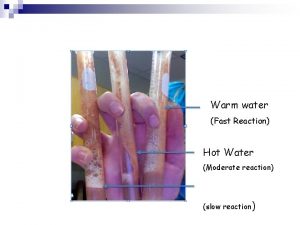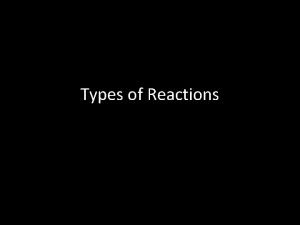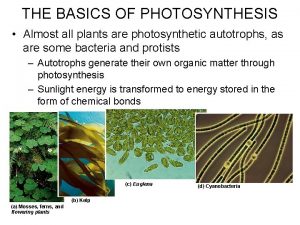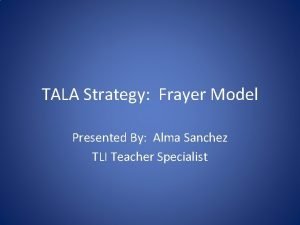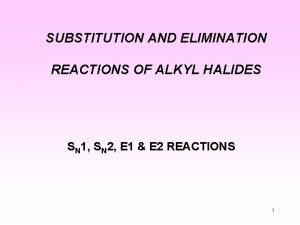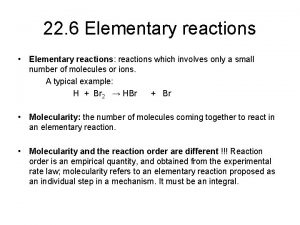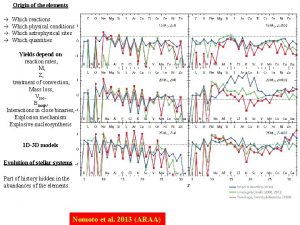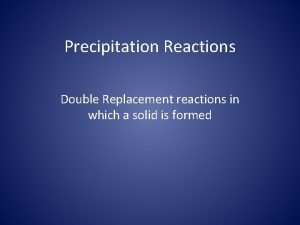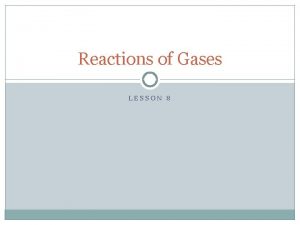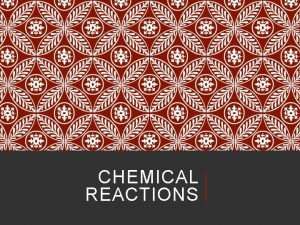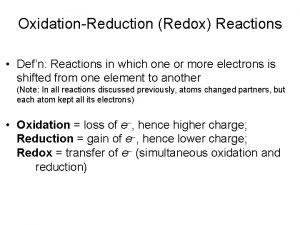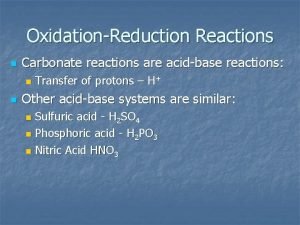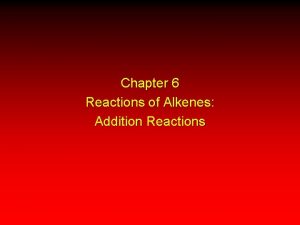22 6 Elementary reactions Elementary reactions reactions which























- Slides: 23

22. 6 Elementary reactions • Elementary reactions: reactions which involve only a small number of molecules or ions. A typical example: H + Br 2 → HBr + Br • Molecularity: the number of molecules coming together to react in an elementary reaction. • Molecularity and the reaction order are different !!! Reaction order is an empirical quantity, and is obtained from the experimental rate law; Molecularity refers to an elementary reaction proposed as an individual step in a mechanism. It must be an integral.

• An elementary bimolecular reaction has a second-order rate law: A + B → P • If a reaction is an elementary bimolecular process, then it has second-order reaction kinetics; However, if the kinetics are secondorder, then the reaction might be complex.

22. 7 Consecutive elementary reactions • An example: 239 U → 239 Np → 239 Pu • Consecutive unimolecular reaction A → B → C The rate of decomposition of A is: • The intermediate B is formed from A, but also decays to C. The net formation rate of B is therefore: • The substance C is produced from the unimolecular decay of B:

• Integrated solution for the first order reaction (A) is: • Then one gets a new expression for the reactant B: the integrated solution for the above equation is: when assuming [B] 0 = 0. • Based on the conservation law [A] + [B] + [C] = [A]0


Example. In an industrial batch process a substance A produces the desired compound B that goes on to decay to a worthless product C, each step of the reaction being first-order. At what time will B be present in the greatest concentration? Solution: At the maximum value of B Using the integrated solution of B and taking derivatives with respect to t: In order to satisfy =0 tmax = The maximum concentration of B can be calculated by plugging the tmax into the equation.

Steady State Approximation • Assuming that after an initial induction period, the rates of change of concentrations of all reaction intermediates are negligibly small. • Substitute the above expression back to the rate law of B 0≈ [B] = (k 1/ k 2)[A] • Then • The integrated solution of the above equation is In a batch reactor, steady state approximation can only be applied to intermediate products, not the final product!

Self-test 22. 8 Derive the rate law for the decomposition of ozone in the reaction 2 O 3(g) → 3 O 2(g) on the basis of the following mechanism O 3 → O 2 + O k 1 O 2 + O → O 3 k 1’ O + O 3 → O 2 + O 2 k 2 Solution: First, write the rate law for the reactant O 3 and the intermediate product O Applying the steady state approximation to [O] Plug the above relationship back to the rate law of [O 3]

Rate determining step

Simplifications with the rate determining step • Suppose that k 2 >> k 1, then k 2 – k 1 ≈ k 2 therefore concentration C can be reorganized as [C] ≈ (1 )[A]0 • The above result is the same as obtained with steady state approximation

Kinetic and thermodynamic control of reactions • Consider the following two reactions A + B → P 1 rate of formation of P 1 = k 1[A][B] A + B → P 2 rate of formation of P 2 = k 2[A][B] • [P 1]/[P 2] = k 1/k 2 represents the kinetic control over the proportions of products.

• Problems 22. 6 The gas phase decomposition of acetic acid at 1189 K proceeds by way of two parallel reactions: (1) CH 3 COOH → CH 4 + CO 2, k 1 = 3. 74 s-1 (2) CH 3 COOH → H 2 C=C=O + H 2 O, k 2 = 4. 65 s-1 What is the maximum percentage yield of the ketene CH 2 CO obtainable at this temperature.

Pre-equilibrium • Consider the reaction: A + B ↔ I → P when k 1’ >> k 2, the intermediate product, I, could reach an equilibrium with the reactants A and B. • Knowing that A, B, and I are in equilibrium, one gets: and • When expressing the rate of formation of the product P in terms of the reactants, we get

Self-test 22. 9: Show that the pre-equilibrium mechanism in which 2 A ↔ I followed by I + B → P results in an overall third-order reaction. Solution: A+ A↔I I+B→P k 1, k 1’ k 2 write the rate law for the product P Because I, and A are in pre-equilibrium so [I] = K [A]2 Therefore, the overall reaction order is 3.

Kinetic isotope effect • Kinetic isotope effect: the decrease in the rate of a chemical reaction upon replacement of one atom in a reactant by a heavier isotope. • Primary kinetic isotope effect: the kinetic isotope effect observed when the rate-determining step requires the scission of a bond involving the isotope: with • Secondary kinetic isotope effect: the variation in reaction rate even though the bond involving the isotope is not broken to form product: with

Kinetic isotope effect

22. 8 Unimolecular reactions • The Lindemann-Hinshelwood mechanism A reactant molecule becomes energetically excited by collision with another reactant molecule: A + A → A* + A The energized molecule, A*, may lose its excess energy by colliding with another molecule: A + A* → A + A The excited molecule may shake itself apart to form product P A* → P The net rate of the formation of A* is

• If the reaction step, A + A → A* + A, is slow enough to be the rate determining step, one can apply the steady-state approximation to A*, so [A*] can be calculated as Then The rate law for the formation of P could be reformulated as Further simplification could be obtained if the deactivation of A* is much faster than A* P, i. e. , then in case

• The equation reorganized into can be • Using the effective rate constant k to represent • Then one has

The Rice-Ramsperger-Kassel (RRK) model • Reactions will occur only when enough of required energy has migrated into a particular location in the molecule. • s is the number of modes of motion over which the energy may be dissipated, kb corresponds to k 2

The activation energy of combined reactions • Consider that each of the rate constants of the following reactions A + A → A* + A A + A* → A + A A* → P has an Arrhenius-like temperature dependence, one gets Thus the composite rate constant also has an Arrhenius-like form with activation energy, E = E 1 + E 2 – E 1’ Whether or not the composite rate constant will increase with temperature depends on the value of E, if E > 0, k will increase with the increase of temperature

Combined activation energy

• Theoretical problem 22. 20 The reaction mechanism A 2 ↔ A + A (fast) A + B → P (slow) Involves an intermediate A. Deduce the rate law for the reaction. • Solution:
 Section 2 classifying chemical reactions worksheet answers
Section 2 classifying chemical reactions worksheet answers Examples of redox reaction
Examples of redox reaction Chemical reactions section 2 classifying chemical reactions
Chemical reactions section 2 classifying chemical reactions Types of reactions
Types of reactions Chemistry unit 5 reactions balancing reactions worksheet
Chemistry unit 5 reactions balancing reactions worksheet What macromolecule is this
What macromolecule is this Tongue twister sea shell
Tongue twister sea shell If two witches
If two witches Which japanese word means harbour waves
Which japanese word means harbour waves Enzyme cut-outs activity
Enzyme cut-outs activity Proportional relationships in chemical reactions
Proportional relationships in chemical reactions Balancing chemical equations definition
Balancing chemical equations definition Balancing redox reactions
Balancing redox reactions Types of reactions
Types of reactions What are the 5 types of reactions?
What are the 5 types of reactions? Example of single replacement reaction
Example of single replacement reaction 4 types of chemical reactions
4 types of chemical reactions Reaction type
Reaction type Predicting products of chemical reactions
Predicting products of chemical reactions 4 types of chemical reactions
4 types of chemical reactions Inputs of light reactions in photosynthesis
Inputs of light reactions in photosynthesis Non examples of chemical reactions
Non examples of chemical reactions Chapter 10 chapter assessment chemical reactions answers
Chapter 10 chapter assessment chemical reactions answers E1 reaction of alkyl halides
E1 reaction of alkyl halides









